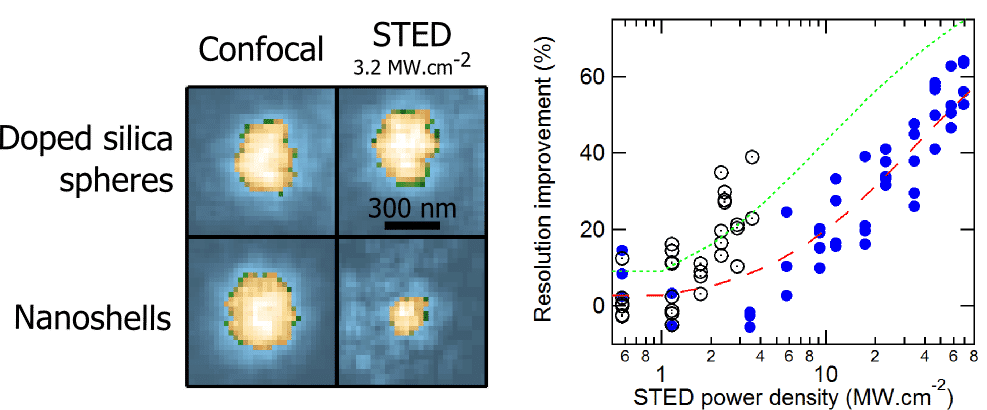
We show Experimentally a 4-Fold Reduction of the Intensity Required to Achieve Sub-Diffraction Resolution in a Stimulated-Emission-Depletion (STED) Microscope with Particles as Small as 30nm
The limit that diffraction puts on imaging was considered as one of the most fundamental problems in wave physics. This limit was broken in the early 2000’s in the context of fluorescence microscopy, eventually resulting in the awarding of the Nobel Prize of 2014.
The most prominent super-resolution technique is probably stimulated-emission-depletion (STED) nanoscopy, which offers superb resolution along with fast acquisition times. The STED nanoscope, however, has still not become a wide-spread tool, mainly because of the high intensities and complicated setup required and the nanoscope`s high cost.
We show that metal nanoparticles can be used to improve the performance of super-resolution fluorescence nanoscopes based on stimulated-emission-depletion (STED). We show theoretically a resolution improvement by more than an order of magnitude, or equivalently, depletion intensity reductions by more than 2 orders of magnitude.
In order to demonstrate the effect experimentally, we compare the resolution attained when imaging dye-doped silica nanoparticles with or without a shell of gold. To do so, at first confocal images of single NPs of the two sets are recorded, followed immediately by a STED image. The same process is repeated for varying STED beam power. We observe that an optimum resolution, limited by the particle sizes, can be reached for the hybrid NPs for a power of the STED beam 4 times smaller than for the bare cores, see Fig. 1, in good agreement with the theoretical calculations. We discuss all the experimental obstacles we encountered and show that all have very satisfactory solutions. Accordingly, we expect to obtain results similar to those predicted theoretically initially once the measurements will be repeated with particles of optimal geometries.
Our experimental demonstration opens the door to improvement of existing STED nanoscopes by assisting in the development of low-power, low-cost nanoscopes, thus, addressing the two major challenges of this technique. This has the potential to increase the availability of STED nanoscopes and lead to a significant expansion of our understanding of biological and biochemical phenomena occurring on the nanoscale.
Finally, we show that metal nanoparticles can be used a several other super-resolution techniques such as linear and nonlinear Structrued-Illumination microscopy (SIM) and SAturated eXcitation microscopy (SAX).

sivanyon@bgu.ac.il
Powered by Eventact EMS